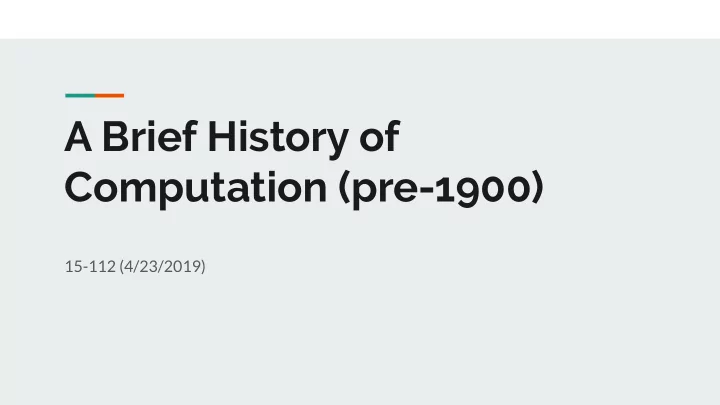

A Brief History of Computation (pre-1900) 15-112 (4/23/2019)
Learning goals ● Become familiar with the history of computing devices from ancient times to the 1800s ● Understand early driving forces of innovation in computation ● See some cool automata and appreciate mechanical computation
Discuss: What is computing? What is a computer? Try to come up with concrete requirements!
Let’s use a loose definition for today Loosely, something that generates an ● output given a particular set of inputs or initial configuration We’ll restrict ourselves to inputs and ● outputs that (mathematically) represent concepts or parts of problems Generally they solve (or allow us to solve) a ● set of problems faster A simple example: multiplication tables ●
Simple computers
Function tables: How do they “work?” It stores precomputed knowledge that we can systematically access to perform calculations faster. To the right is an image of a rather intimidating logarithm table ---->
The abacus: 2500BC to present Originally lines drawn in sand, pebbles ● Oldest known “computer,” excluding simple ● counting aids like tally sticks Procedural interaction allows user to ● perform four-function math on large numbers by storing an intermediate state Still in widespread use until recent decades ● Japanese soroban was taught nationally and ○ used in business until recently ● http://www.mathematik.uni-marburg.de/~th ormae/lectures/ti1/code/abacus/soroban.ht ml
Napier’s Bones (1617) Physical aid for multiplying large numbers Represented with pen and paper or with inscribed rods: http://mathworld.wolfram.com/NapiersBones.html John Napier also invented logarithms!
Slide rules: 1620 - 1950 Basic principle: Multiplication and division can be quickly performed using the sum of logarithms! https://en.wikipedia.org/wiki/Slide_rule
Mechanical calculators (1623 - 1970)
Similar function to previous tools, but meant to be more convenient or automatic
Antikythera mechanism
Mechanical complexity is ancient Antikythera mechanism: 2100 years old ● Accurately calculates celestial positions, ● eclipses, etc https://www.youtube.com/watch?v=UpLcn ● AIpVRA&feature=youtu.be&t=164 Discuss: Why might this have been built? ●
Navigation! A major incentive for innovation
Discuss the following questions If you can see three landmarks, how do you find where you are on a map? ● Without a compass, how can we (accurately) determine which way is north? ● If you can’t see landmarks, how can you determine latitude (north/south position)? ●
Positional navigation using landmarks
Sextants, astrolabes, etc for measuring angles
Discuss: Why is longitude harder to determine? What do we need to know first?
Time! Can’t navigate across an ocean without knowing the time.
Why is time important for navigational calculations? When we travel long distances, the sky ● changes Small errors are a big deal over large ● voyages So let’s build a clock! Why is this hard? ● Mechanical ○ No way to correct fast/slow if clock if you’re ○ alone in the ocean (don’t know where) Clock must be extremely accurate and ○ precise, even through rough weather
Quick aside: How long have battery-powered watches been widespread?
Quick aside: How long have battery-powered watches been widespread? ...about 35 years. Before the 1980s, most watches were entirely mechanical. The first “electric” watches from 1969 were absurdly expensive and still relied on mechanical regulation of time. The first all-digital watch cost more than $2k when it first came out in 1970.
Discuss: What functional parts do we need for a mechanical timekeeper?
Discuss: What functional parts do we need for a mechanical timekeeper? 1. A way to store energy (a spring) 2. A way to convert between seconds, minutes, and hours (gears) 3. Most importantly: A way to move the hands at a very constant rate. Ideate: How would you do that?
The Escapement Why watches and clocks “tick” ● https://en.wikipedia.org/wiki/Escapement ● The escapement keeps the spring from ● rapidly unwinding A pendulum (or escape wheel, i.e. a rotary ● pendulum) allows the gears to advance a fixed amount at every oscillation The escapement also injects energy to keep ● the pendulum moving Explanatory video: https://youtu.be/rL0_vOw6eCc?t=370
Back to navigation Early timepieces were still inaccurate ● Isochronism: The ability to keep time at a ● constant rate over long periods of time 1714: British government offers the ● Longitude Prize, $4 million in 2019 currency for the first clock accurate enough for navigation John Harrison wins the prize in 1761 after ○ 31 years of dedicated work to improve the escapement Chronometer escapement: ○ https://www.youtube.com/watch?v=cQvop njDI6E
From watches to automata: Machines with programs
Birdcage demonstration This machine executes a mechanical program! Automata became popular in the 1700s, though there are ancient examples as well
Other (more impressive) automata Brittany Nicole Cox and Antiquarian Horology: https://www.youtube.com/watch?v=irdTng8MbIE Late 1700s Creepy music robot: https://www.youtube.com/watch?v=nITEU4fsqCU Late 1700s Writing robot: https://www.youtube.com/watch?v=C7oSFNKIlaM
Which automaton or device did you find most interesting so far? Submit your answer (and your attendance) to: http://bit.ly/112attend-gears
Programmable computing
Jacquard loom Complex textile patterns achieved using a series of punch cards https://www.youtube.com/watch?v=MQzpLLhN0fY
Charles Babbage Difference engine: Analytical engine: General-purpose computer Tabulated values for polynomial functions, Capable of arithmetic, conditionals, and ● ● potentially saving lots of manual labor looping https://www.youtube.com/watch?v=XSkGY6LchJs Fully designed but never built ● ●
Ada Lovelace Published first algorithms designed specifically for [ The Analytical Engine] might act upon other things besides a computer (the analytical engine) number , were objects found whose mutual fundamental relations could be expressed by those of the abstract science of operations, and which should be also susceptible Wrote extensively about the applications of of adaptations to the action of the operating notation and computers beyond the purely mathematical mechanism of the engine
This brings is to the 1900s, where... More mechanical (and then electro-mechanical computers) were built ● WWII saw the practical use of computers and computational theory in cryptography ● Computers became ever more general-purpose ● Limits of computation and other theoretical research took off ● Innovations in miniaturization and electronics (i.e. transistors) propelled us into our current age of ● small, inexpensive computing and vastly powerful supercomputers
That’s it for today! If you’re interested in this topic, look at the website for History of Computing 15-292 and consider taking it next time it’s offered!
Recommend
More recommend